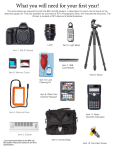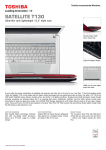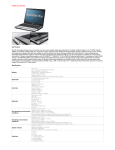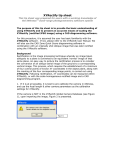Download Olympus E-330 EVOLT Review
Transcript
Olympus E-330 EVOLT Review
March 2006 | By Phil Askey
Review based on a production E-330
On January 26th 2006 over a year since the introduction of the E-300 Olympus
revealed the 7.5 million pixel 'live view' successor, the E-330. The E-330's biggest
differentiation to any other digital SLR is its capability to deliver a live view on the
LCD monitor (in the same manner as a prosumer / consumer all-in-one digital
camera). For those new to digital SLR's this is difficult to achieve because of the
mirror / shutter mechanism, the mirror is in the light path in view mode to
provide an image to the viewfinder, this means that no image can be projected
onto the main sensor. Additionally most large D-SLR sensor don't have video out
capability. Other changes over the E-300 include a flip-out LCD screen and a
range of feature improvements inherited from the E-500.
Live View
The E-330 achieves live view in one of two ways; in A Mode ('Full-time live view')
the mirror stays in place and you can continue to use the viewfinder, the live view
image is produced using a small secondary CCD sensor in the viewfinder chamber
(as suggested by me five years ago). In B Mode ('Macro live view') the mirror
flips up, the shutter opens and the live view is provided by the E-330's unique
'Live MOS' sensor. There are significant differences between the two modes:
UPDATE 22/06/06: With the introduction of firmware 1.2 the E-330 now provides
an Auto Focus feature in Live View B mode, it achieves this by dropping the
mirror (blanking the Live View), focusing and then returning to Live View. This
will obviously be slower than Auto Focus in viewfinder mode.
A Mode
(full-time live view)
B Mode
(macro live view)
Method
Using small CCD sensor Using 'Live MOS' sensor
in viewfinder chamber with mirror up and
shutter open
Auto focus
Yes
Yes, with firmware 1.2
Metering
Normal *1
Not indicated *2
Viewfinder
Available
Unavailable (mirror up)
Frame coverage
92%
100%
Shutter release
Normal
Delayed approx. 1
sec *3
Frame assist
Passport modes
Golden section, Grid,
Scale
Live view magnify No
Yes, 10x
Depth of field
Not representative
Absolutely accurate
DOF preview
Yes, via button
Yes, via button
The user manual does note that the most accurate metering is
*1 only available in this mode with the eyepiece shutter closed
(because of stray light entering view the viewfinder).
The E-330's metering sensor is in the viewfinder chamber and so
*2
exposure is only measured when the shutter release is pressed.
Because the mirror has to come down and the shutter close
*3
before the exposure can be taken (also for metering, see *2).
Compared to the E-300 EVOLT feature and specification
differences
Sensor
Olympus E-330 EVOLT
Olympus E-300 EVOLT
• 4/3 Type 'Live MOS'
(NMOS)
• 7.5 million effective pixels
• Kodak 4/3 Type CCD
• 8.0 million effective pixels
Image sizes •
•
•
•
3136
2560
1600
1280
x
x
x
x
2352
1920
1200
960
•
•
•
•
3264
3200
2560
1600
x
x
x
x
2448
2400
1920
1200
• 1024 x 768
• 640 x 480
• 1280 x 960
• 1024 x 768
• 640 x 480
Metering
sensor
New 49 area (7 x 7 matrix)
Unspecified
Metering
modes
•
•
•
•
•
Digital ESP
Center-Weighted Average
Spot
Highlight based spot
Shadow based spot
• Digital ESP
• Center-Weighted Average
• Spot
ISO
• Auto (ISO 100 - 400)
sensitivities • ISO 100
• ISO 125
• ISO 160
• ISO 200
• ISO 250
• ISO 320
• ISO 400
• ISO 500 *
• ISO 640 *
• ISO 800 *
• ISO 1000 *
• ISO 1250 *
• ISO 1600 *
* With ISO Boost set to On
• Auto (ISO 100 - 400)
• ISO 100
• ISO 200
• ISO 400
• ISO 800 *
• ISO 1600 *
* With ISO Boost set to On
Noise filter
Unspecified
• New High ISO noise filter
• Optionally enabled
HQ
• 1/2.7
compression • 1/4
options
• 1/8
• 1/12
• 1/4
• 1/8
Focus
modes
•
•
•
•
•
•
•
•
•
MF
bracketing
Yes
No
WB
bracketing
• 3 frames
• 5, 10 or 15 mired steps
• 3 frames
• 1, 2 or 3 steps
S-AF
C-AF
MF
S-AF & MF
C-AF & MF
S-AF
C-AF
MF
S-AF & MF
Continuous • 3.0 fps
• RAW: 4 frames
• JPEG: 15 frames max
• 2.5 fps
• RAW: 4 frames
• JPEG: 4 frames
My Mode
No
Yes
B&W Mode Selectable filters
Fixed monochrome filter
Custom WB 1 memory
3 memories
Kelvin WB
2000 - 14000 K
2000 - 10000 K
Flash
bracketing
Yes
No
Scene
modes
•
•
•
•
•
•
•
•
•
•
•
•
•
•
•
•
•
•
•
•
•
•
•
•
•
•
•
•
•
•
•
•
•
•
Portrait
Landscape
Landscape & Portrait
Night Scene
Night Scene & Portrait
Children
Sports
High Key
Low key
D Image Stabilization
Macro
Natural Macro
Candle
Sunset
Fireworks
Documents
Panorama
Beach & Snow
Under Water Wide
Under Water Macro
Info. display • Two levels
• Color selectable
Record
review
Portrait
Landscape
Landscape + Portrait
Night Scene
Night Scene + Portrait
Macro
Sunset
Candle
Fireworks
Documents
Museum
High Key
Beach & Snow
Sport
One level
Any of the seven play display Single image, no histogram
modes
Play display • No overlaid information
modes
• Basic overlay
• More detailed overlay
• Thumbnail, AF point, 4 way
histogram
• Large histogram overlay
• Blinking highlights
• Blinking shadows
•
•
•
•
•
•
No overlaid information
Basic overlay
More detailed overlay
Large histogram overlay
Blinking highlights
Thumbnail, AF point, info
Play
magnify
Up to 14x
Up to 10x
Play index
4, 9, 16, 25 frames, Calendar 4, 9, 16 frames
Play
marking
Yes, batch erase and copy
No
Red-eye fix Yes, play mode 'Edit'
No
Storage
• Compact Flash
• xD-Picture Card
Compact Flash
Viewfinder
•
•
•
•
•
•
•
•
Side mounted Porro Finder
94% field of view
1.0x magnification
Clip-fit eyecup
Side mounted Porro Finder
94% field of view
1.0x magnification
Fixed eyecup
• Eye-piece shutter
LCD monitor •
•
•
•
2.5" TFT LCD monitor
215,250 pixels
Wide viewing angle
Flip-out and up
Live view on Yes, two modes
LCD
• 1.8" TFT LCD monitor
• 134,000 pixels
No
Dimensions 140 x 87 x 72 mm (5.5 x 3.4 147 x 85 x 64 mm (5.8 x 3.4
x 2.8 in)
x 2.5 in)
DC-IN
No
Yes
Weight
• No battery: 539 g (1.2 lb) • No battery: 580 g (1.3 lb)
• With battery: 617 g (1.4 lb) • With battery: 624 g (1.4
lb)
Live MOS Sensor technical information
(A Press Release provided by Olympus)
Features
The Live MOS Sensor offers image quality comparable to a Full Frame Transfer
(FFT) CCD sensor with the low power requirements of a CMOS sensor, and is
noteworthy for its high-quality imaging capabilities over an extended period of
time. Simplified circuitry that reduces the distance from each photodiode to its
corresponding on-chip microlens assures excellent sensitivity and image quality
even when light strikes it at a high angle of incidence.
Resolution: 7.5 megapixels, with excellent low-light performance
characteristics.
Grain: low-noise technologies assure reduced graininess.
Tonal range: Simplification of the transfer register and other circuitry
results in a large photodiode surface area for FFT-CCD-level sensitivity and
responsiveness.
Low power consumption: Power requirements are approximately half those
of FFT-CCD sensors.
High speed: Simple circuit structure contributes to faster processing
overall.
Redesigned Sensor Elements with Greater Photosensitive Surface Area
The Live MOS Sensor takes advantage of the simplified circuit requirements and
thinner layer structure of NMOS type sensors to offer a larger photosensitive
surface area. In addition, circuit technology refinements were made to boost light
utilisation efficiency and improve image quality.
A new transfer mechanism for photodiode signal readout enabled us to reduce
the number of circuit paths to two, the same as in a CCD sensor, and thereby
minimise the surface area that is unresponsive to light. By effectively enlarging
the photosensitive surface area and enabling it to capture light that was
previously lost, we were able to achieve both high sensitivity and superior image
quality. We also developed a new low-noise photodiode signal amplification circuit
to further improve sensitivity.
Low-Noise Technology for Significantly Improved Imaging in Low-Light
Environments
A dedicated processing technology developed for use in 5V (design specifications:
2.9V) low-voltage systems is employed to significantly reduce noise. Operating
signal noise was also considered, and the sensor photodiodes were deeply
embedded in silicon to isolate them from noise-causing elements on the chip
surface. As a result, images are clearer, and the graininess and white noise that
often appear when shooting in low light are suppressed. Thanks to this
technology, low-light performance is improved overall, and a clear image can be
obtained even when shooting in very dim light.
If you're new to digital photography you may wish to read the Digital
Photography Glossary before diving into this article (it may help you understand
some of the terms used).
Conclusion / Recommendation / Ratings are based on the
opinion of the reviewer, you should read the ENTIRE review
before coming to your own conclusions.
Images which can be viewed at a larger size have a small
magnifying glass icon in the bottom right corner of the image,
clicking on the image will display a larger (typically VGA)
image in a new window.
To navigate the review simply use the next / previous page
buttons, to jump to a particular section either pick the section
from the drop down or select it from the navigation bar at the
top.
DPReview calibrate their monitors using Color Vision OptiCal at
the (fairly well accepted) PC normal gamma 2.2, this means
that on our monitors we can make out the difference between
all of the (computer generated) grayscale blocks below. We
recommend to make the most of this review you should be
able to see the difference (at least) between X,Y and Z and
ideally A,B and C.


















